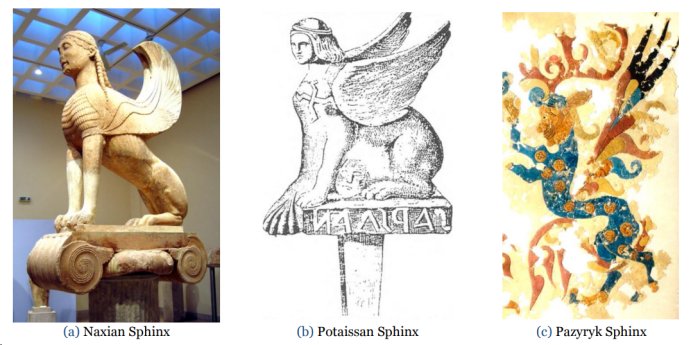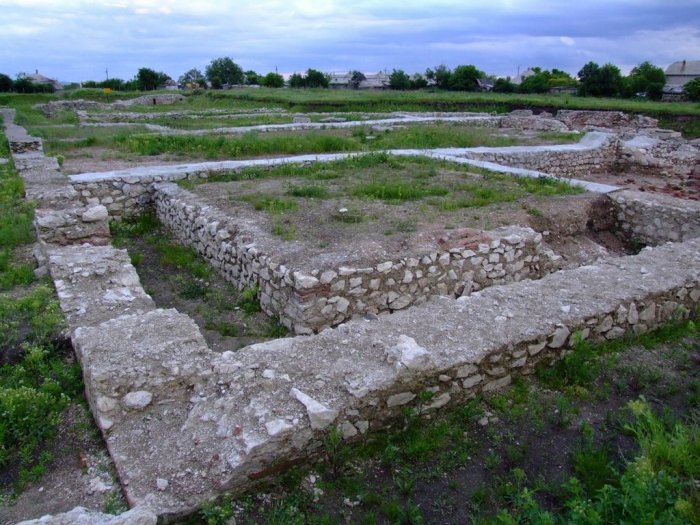Jan Bartek – AncientPages.com – It often takes patience and time to solve ancient enigmas. Scientists have tried for over a century to decipher a mysterious inscription etched into an ancient sphinx originating from Dacia. According to a new study, the research team has finally succeeded and can now read the unusual ancient message.

(a) The sphinx of the Naxians stood on top of a column in front of the Temple of Apollo at Delphi, Greece, in 560 BCE, which is now located in the Archaeological Museum of Delphi. (b) A drawing of the Potaissan sphinx, (c) A Pazyryk sphinx with twelve star symbols
Image credits: (a) Wikipedia, (b)Illustrierten Zeitung,1847, no. 188, (c) Siberian Times
Most ᴀssociate the sphinx statue with ancient Egypt, where the Great Sphinx is most prominent, but many ancient cultures were familiar with the curious animal. Ancient sphinx statues have been found in Greece, Turkey, India, Iraq, and many other places.
The Sphinx Of The Naxians Had A Female Face
Ancient Egyptian sphinxes were depicted as mostly male statues with a lion’s body and a pharaoh’s head, but the sphinx could also have a different appearance. The sphinx had a particularly strong ᴀssociation with Naxos. In the Archaeological Museum of Delphi, one can see the famous sphinx of the Naxians, which stood on top of an Ionian column in Delphi in front of the Temple of Apollo from 560 B.C.
In contrast to the Egyptian sphinxes, the sphinx of the Naxians depicts a winged lion with a female face. This Naxian-style representation became common in Europe during later Greek and Roman times.
In the early 19th century, a bronze sphinx very similar to the famous Naxian Sphinx was discovered in Potaissa, a town in the Roman province of Dacia. The Roman colonial period in Dacia lasted from 106 to 275 C.E., and the colonists came from all over the Roman Empire. Potaissa was a Dacian settlement. Decebalus (Decebal) – ‘the brave one’ – was the last king of Dacians, a people who lived in the territory known presently as Romania.

Roman bath at Castra Potaissa. Credit: CristianChirita – CC BY 2.5
Later, the Dacian sphinx from Potaissa was stolen from a European count sometime around 1848. Unfortunately, the bronze sphinx was never recovered, but there was still a detailed drawing of the statue. This drawing has fascinated scientists as it shows a curious inscription composed of a handful of characters at the base of the Naxian-style sphinx statue.
Inscription On The Potaissan Sphinx
It has been impossible to decipher the inscription until now. Researchers now figured out that one of the reasons they could not decode the inscription is because, in an “unusual” break from ancient norms, the text reads from right to left.
“The translation not only satisfies many researchers curiosity, who have pondered this artifact over decades, but it contributes to a broader understanding of cultural life in the Roman province of Dacia in the third century BCE. The minority religions that existed in the Roman Empire are less well-known than the predominant Roman religion. Some of the sects had an almost hidden presence and not much is known about them.
Therefore, the discovery of this artifact, and its identification as an artifact bearing a religious text, is very important to help complete our picture of this aspect of Roman provincial culture,” the researchers write in their study published in the journal Mediterranean Archaeology and Archaeometry.
After examining ancient alphabets, scientists determined the message is a proto-Hungarian poem written with Greek letters. “The characters may seem mysterious at first, but once the mirroring is noticed, the characters become easily recognizable as Greek alphabet letters, a few of them being in a more archaic form,” Peter Revesz, the study author and professor at the University of Nebraska, said.

The inscription on the pedestal of the Potaissan sphinx. Credit: Mediterranean Archaeology and Archaeometry
The English translation of the poem reads, “Lo, behold, worship: here is the holy lion,” which can be perceived as a command to venerate the sphinx.”
This is an intriguing inscription because “the sphinx cult was not part of the mainstream ancient Roman mythology which features the Roman gods and goddesses that many people today are familiar with.
It is unique that this sphinx statue provides some record of a minority religion within the Roman empire, for which records are much scarcer,” Revesz explained.
The text is also unusual because it is written as a metric poem, whereas most inscriptions at the time were written in prose.
“By using these poetic features, the scribe chose a specific text that was also carefully and artfully constructed,” Revesz said.
See also: More Archaeology News
“Poetry is usually ᴀssociated with larger Roman cities where an artistic culture thrived in the Roman age. This fame often takes away the attention from provincial culture, which is lesser known for poetic works. It is interesting to see that in the provincial area of Dacia, poetry also thrived as well as visual art as represented by the imaginative figure of the sphinx,” the study informs.
Written by Jan Bartek – AncientPages.com Staff Writer





